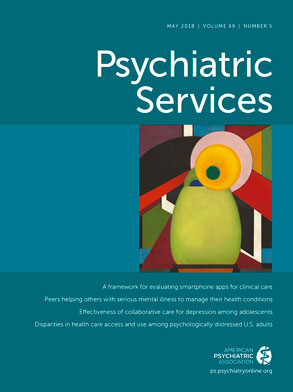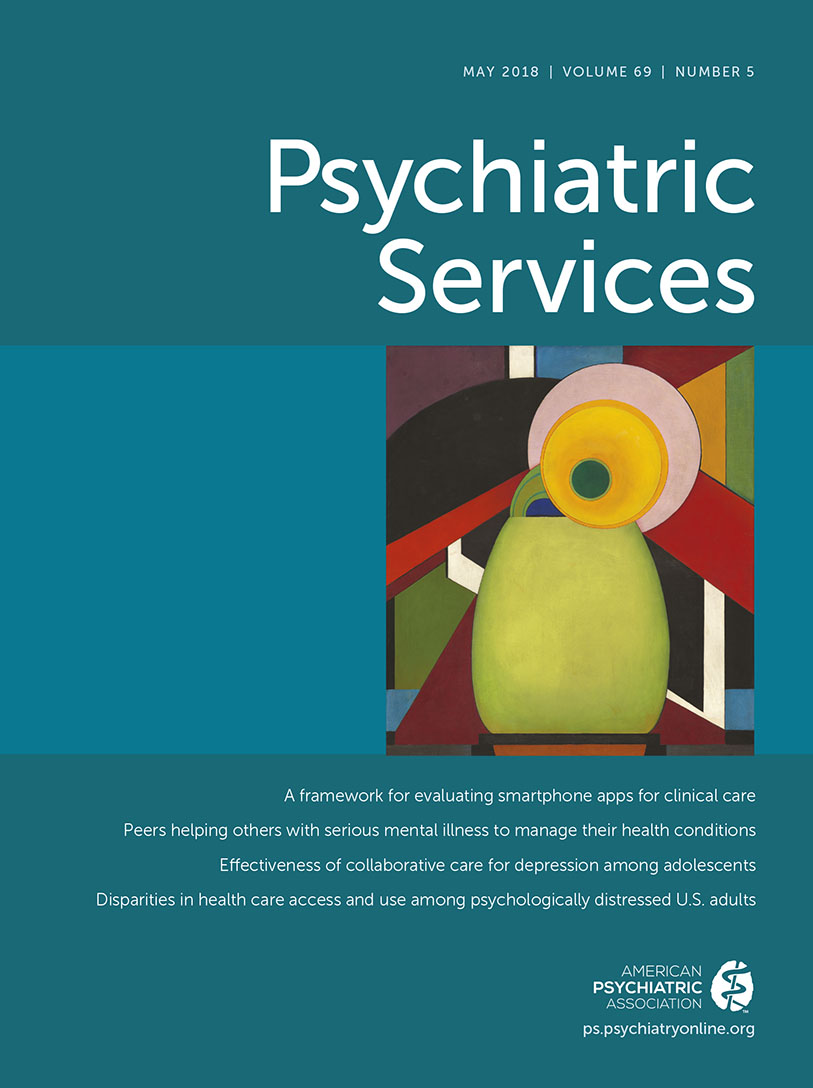Antipsychotic medications are considered the cornerstone of treatment for schizophrenia and related disorders, but antipsychotics alone are rarely adequate to address all of the symptoms and functional limitations of affected individuals. Other classes of psychotropic medications are frequently prescribed, but there is little high-quality evidence about their effectiveness or safety in this population (
1). Systematic reviews, including those conducted by the Schizophrenia Patient Outcomes Research Team (PORT) (
2) and the Cochrane Schizophrenia Group (
3–
5), have found that evidence regarding the effectiveness of psychotropic medications other than antipsychotics among persons with schizophrenia is inadequate or inconclusive. Only recently did a meta-analysis find evidence to support use of antidepressants for depressive and negative symptoms (
6). Further, little clinical research has focused exclusively on schizoaffective disorder, although it is widely understood that antidepressants and mood stabilizers may be appropriate to treat depression and mania in patients in this group (
7).
Although antipsychotic polypharmacy (the simultaneous use of more than one antipsychotic medication) has received considerable attention (
8), little is known about the extent of other types of psychotropic medication use or the effects of these medications in community practice. One previous investigation used Medicaid data from two states to compare treatment patterns for schizoaffective disorder and schizophrenia and found more complex treatment regimens for people with schizoaffective disorder (
9), but the primary focus of the study was not medications. The investigation reported here used a national administrative data set to investigate the extent and patterns of all types of psychotropic medication use among adults with schizophrenia and schizoaffective disorder in the United States. Because the use of medications other than antipsychotics in this population is not based on strong evidence, and because of the possibility of serious risks as well as benefits, a better understanding of their use is needed.
Methods
We conducted a retrospective cohort study using U.S. Medicaid Analytic Extract (MAX) data from January 1, 2009, through December 31, 2010. This database includes information from 45 state Medicaid programs, excluding Arizona, Delaware, Nevada, Oregon, Rhode Island, and the District of Columbia, which were unavailable, and includes demographic and clinical information, inpatient and outpatient utilization data, and outpatient prescription data for Medicaid enrollees.
Because the focus was on psychotropic medication use over the course of a year, enrollment in Medicaid in 2009 and for the entire year of 2010 was required for cohort members. The primary analytic cohort consisted of adults (age 25–64) with two or more outpatient diagnoses or one or more inpatient schizophrenia diagnoses (
ICD-9-CM 295.x) in 2009 and a prescription claim for at least one psychotropic medication during 2010. Patients were considered to have schizophrenia unless a majority of
ICD-9-CM 295.x claims during the eligibility period had a primary diagnosis of schizoaffective disorder (
ICD-9-CM 295.7). Data on medical comorbidities also came from claims data in 2009 and were coded according to single-level diagnoses by using Clinical Classifications Software for
ICD-9-CM (
10).
All filled prescriptions for at least 15 days for antipsychotics, antidepressants, mood stabilizers, sedative-hypnotics including benzodiazepines, and stimulants were included. Prescriptions for fewer than 15 days were excluded to focus on persistent rather than short-term treatment. All filled prescriptions for long-acting injectable antipsychotics were included. Use of both an oral and long-acting formulations of a single antipsychotic was considered to be use of only one medication. Because pharmacy claims do not provide information on whether prescribers intended combination treatment or were cross-tapering medications, we did not focus on the simultaneous use of combinations of medications.
Patients with schizophrenia and schizoaffective disorder were first characterized according to demographic and clinical variables, including number of medical and psychiatric comorbidities and psychiatric hospital admissions. Patients were classified dichotomously according to whether they filled any prescription for that class. We also examined the schizophrenia and schizoaffective disorder groups with respect to total number of unique psychotropic medications used within each class as well as the total number used over the course of the year. Because of the very large number of patients in the cohort, we do not present significance tests, because virtually all comparisons would meet usual standards of statistical significance.
The New York State Psychiatric Institute’s Institutional Review Board reviewed this study and did not consider it to be human subjects research.
Results
In a preliminary analysis, 116,249 of 126,041 (92.2%) individuals who met the clinical diagnosis criteria for schizophrenia and 84,537 of 90,292 (93.6%) who met the diagnosis criteria for schizoaffective disorder received one or more psychotropic medications in 2010. Among the primary analytic study cohort, which comprised individuals who received at least one psychotropic medication, only 10.6% of patients with schizoaffective disorder and 27.0% of patients with schizophrenia were treated exclusively with antipsychotic medications; 86.1% of patients with schizoaffective disorder and 70.1% with schizophrenia received more than one class of psychotropic medication (
Table 1).
Compared with individuals who had a diagnosis of schizophrenia, those with schizoaffective disorder were more likely to fill prescriptions for antidepressants (65.5% versus 50.1%), mood stabilizers (50.6% versus 32.3%), sedative-hypnotics (43.5% versus 33.4%), and stimulants (3.7% versus 2.2%). [A table showing these data is available as an online supplement to this report.] In both diagnostic groups, women were more likely than men to fill prescriptions for antidepressants and sedative-hypnotics [see online supplement]. In both the schizoaffective disorder and schizophrenia groups, non-Hispanic blacks had lower rates of antidepressant, sedative-hypnotic, and mood stabilizer use compared with Hispanics, who had lower rates of use than non-Hispanic whites [see online supplement].
Some trends were apparent across age groups for both diagnostic groups. Adults ages 35–49 were less likely than younger and older age groups to fill prescriptions for antidepressants. Use of sedative/hypnotics increased with age, whereas use of mood stabilizers decreased with age [see online supplement].
Most people with a diagnosis of schizophrenia or schizoaffective disorder were treated with multiple unique psychotropic medications during a single calendar year, with a modal number of two for schizophrenia and three for schizoaffective disorder [see figure in the online supplement]. Overall, 17.8% of patients with schizophrenia and 29.9% of patients with schizoaffective disorder filled prescriptions of at least 15 days in duration for five or more psychotropic medications. Antipsychotics made the largest contribution to the total number of psychotropic medications [see online supplement].
Discussion
Using a large national database, this report provides a unique perspective on psychotropic medication use among people with a diagnosis of schizophrenia or schizoaffective disorder. Rather than focusing on the simultaneous use of multiple antipsychotic or psychotropic medications, generally known as polypharmacy, we investigated exposure to different classes of psychotropic medications over the course of a year. Our approach required no assumptions about whether combinations were intended for short- or long-term use and no arbitrary decisions about the duration of overlapping prescriptions. The results provide a broad view of how psychotropic medications are prescribed for individuals with schizophrenia and schizoaffective disorder in routine community practice.
As expected, prescriptions for antipsychotic medications were nearly universally filled by the two study groups. In addition, we found that antidepressants, mood stabilizers, and sedative-hypnotics were extensively used among individuals with a diagnosis schizophrenia or schizoaffective disorder. More psychotropic medications were used by individuals with schizoaffective disorder, as might be expected by the requirement for both psychotic and mood symptoms in the diagnostic criteria (
11). Although the presence of mood and anxiety symptoms provides a rationale for use of psychotropic medications other than antipsychotics for these conditions, only recently did a meta-analysis report that antidepressants have a beneficial effect on depressive and negative symptoms in people with schizophrenia (
6). Other systematic reviews, for example from the Schizophrenia Patient Outcomes Research Team (PORT) (
2), and meta-analyses from the Cochrane Schizophrenia Group have failed to find definitive support for using combinations of antipsychotics or for adjunctive use of lithium, valproate, carbamazepine, lamotrigine, or benzodiazepines (
12).
The study had limitations. Although pharmacy claims data confirm that prescriptions were filled, these data do not provide evidence about whether the drugs were ingested. The clinical diagnoses available in the Medicaid claims were not subject to validation by research diagnostic interviews. Because we only included patients who were enrolled in Medicaid for an entire year, the study population may not be representative of all individuals with schizophrenia. However, approximately two-thirds of adults with schizophrenia in the United States are insured by Medicaid (
13). We did not conduct multivariable analyses that might identify diagnostic differences to explain differences in prescribing patterns for various subgroups; nevertheless, the patterns we report accurately reflect practice in the community. We did not present statistical testing because our intent is purely descriptive. Concurrent prescribing or polypharmacy has clear risks of increased side effects and drug interactions. The prescribing information we provide does not directly address this issue. Rather our data draw attention to prescribing that is unsupported by evidence and to uncertainty about treatments.
The racial and ethnic differences in patterns of prescribing psychotropic medications are consistent with previously noted disparities in access to mental health care (
14). In this case, lower rates of other psychotropic use among black and Hispanic patients with schizophrenia are more in agreement with treatment guidelines and imply less exposure to medications that do not have clear evidence of effectiveness. However, it is also possible that these patterns reflect receipt of care by these patients in settings with fewer resources and receipt of less complete evaluations that led to poorer recognition of mood and anxiety problems.
Women made up 55.7% of the schizoaffective group but only 41.2% of the schizophrenia group. Within both of these groups, women filled prescriptions for antidepressants and sedative-hypnotics at higher rates than men. Both of these findings suggest that mood symptoms are either more common or are more often recognized among women with schizophrenia-spectrum disorders than among men with schizophrenia-spectrum disorders, as is the case in the general population.
This study found that individuals with schizophrenia-spectrum disorders in routine practice in the U.S. are commonly prescribed many different psychotropic medications within a single year. Because such individuals may experience a wide range of symptoms for which optimal management strategies have not been determined, psychiatrists must respond to diverse patient needs according to their experience and best clinical judgment. Nevertheless, the use of medications that do not have clear evidence of effectiveness is potentially troubling because of the risk of side effects and drug interactions. Although the use of multiple psychotropic medications may indicate a situation in which effective clinical practice is ahead of evidence from research, the widespread use of unproven pharmacologic approaches for people with schizophrenia and schizoaffective disorder highlights the need to expand the evidence base regarding the appropriate use of these treatment strategies. Empirical evidence is needed to determine the appropriate use, if there is any, of combinations of antipsychotic medications, adjunctive mood stabilizers, sedative-hypnotics, and antidepressants for individuals with schizophrenia or schizoaffective disorder. Because of the numerous clinical situations with uncertain treatment and the availability of multiple commonly used medications, well-designed and conducted observational studies may have an important role in evaluating the comparative effectiveness of various pharmacological treatment strategies.

